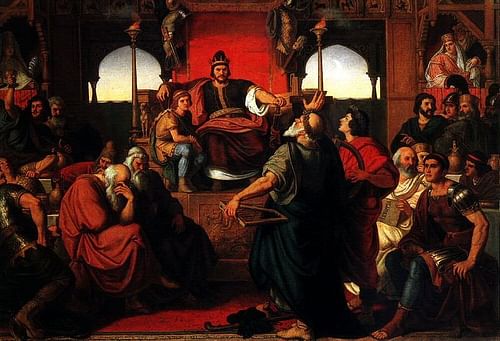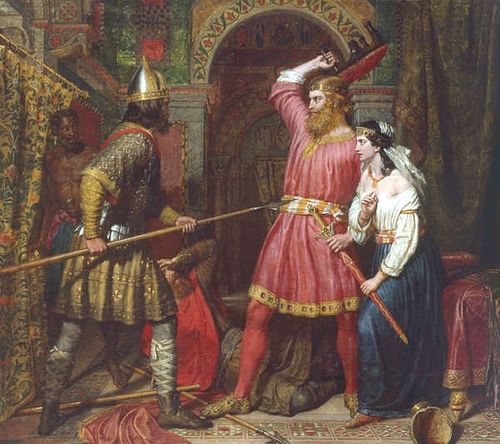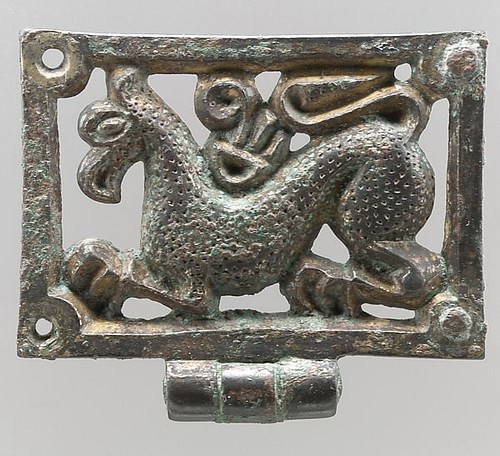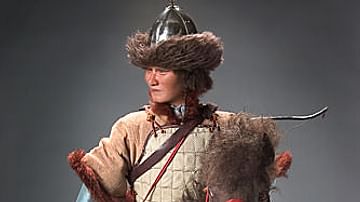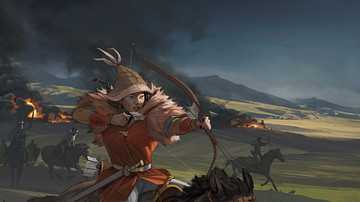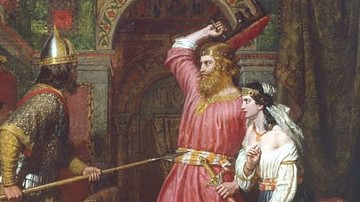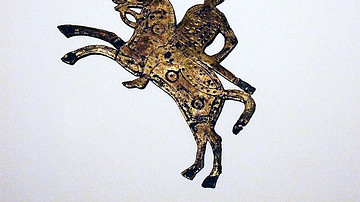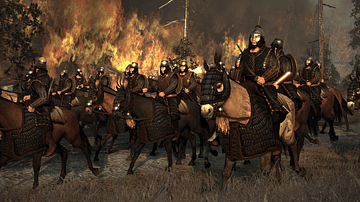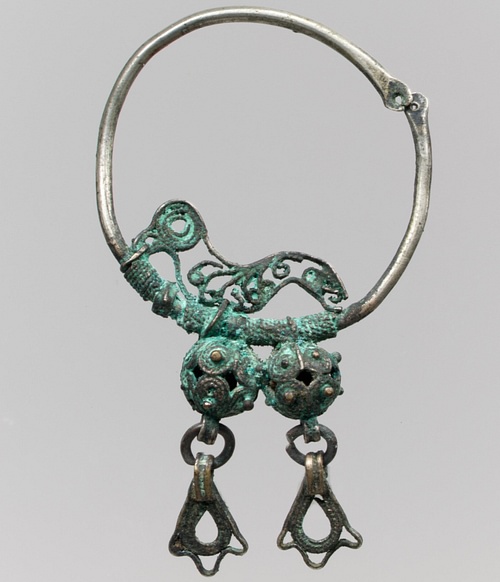
The Avars were a confederation of heterogeneous (diverse or varied) people consisting of Rouran, Hephthalites, and Turkic-Oghuric races who migrated to the region of the Pontic Grass Steppe (an area corresponding to modern-day Ukraine, Russia, Kazakhstan) from Central Asia after the fall of the Asiatic Rouran Empire in 552 CE. They are considered by many historians to be the successors of the Huns in their way of life and, especially, mounted warfare. They settled in the Huns' former territory and almost instantly set upon a course of conquest. After they were hired by the Byzantine Empire to subdue other tribes, their king Bayan I (reigned 562/565-602 CE) allied with the Lombards under Alboin (reigned 560-572 CE) to defeat the Gepids of Pannonia and then took over the region, forcing the Lombards to migrate to Italy.
The Avars eventually succeeded in establishing the Avar Khaganate, which encompassed a territory corresponding roughly to modern-day Austria, Hungary, Romania, Serbia, Bulgaria down to and including parts of Turkey. The departure of the Lombards for Italy in 568 CE removed another hostile people from Pannonia, enabling Bayan I to expand his territories with relative ease and found the empire which lasted until 796 CE, when the Avars were conquered by the Franks under Charlemagne.
Origins & Migration
The precise origin of the Avars (like that of the Huns) is debated, but many historians, such as Christoph Baumer, link them with the Rouran Khaganate of Mongolia, north of China. The Rouran Khaganate was overthrown by the Gokturks in 552 CE, and the people, led by the Xianbei Mongolians, fled west to escape their rule. This claim seems the most likely but is not accepted by all scholars. The Ju-Juan tribe of Mongolia allied themselves with the White Huns against the people known as the Toba (who were Turkish) in numerous engagements and established themselves as an empire in the Mongolian region c. 394 CE. This empire became known as the Rouran Khaganate, which fell to the Gokturks in 552 CE, shortly before the Avars appear in the Steppe c. 557 CE, and so Baumer, and those who agree with him, appear to be correct.
The first mention of the Avars in Roman history comes from Priscus of Panium in 463 CE, who mentions the Avars in connection with a tribe known as the Sabirs who appear to be a subset of the Huns. Priscus is one of the primary sources on the Huns (he met and dined with Attila in 448/449 CE while on a diplomatic mission) and took note of their activities following the death of Attila in 453 CE. The Hunnic Empire which Attila established was in the process of disintegrating at this time (c. 463 CE), beginning with the Hun defeat by Ardaric of the Gepids in 454 CE at the Battle of Nedao.
Following Nedao, other nations that had been subjugated by the Huns rose against them, and the Hunnic Empire was dismantled by 469 CE. Whether the Avars mentioned by Priscus are the same coalition as those who fled Mongolia in 552 CE is debated. Many of the so-called "barbarian" tribes mentioned by Roman writers (the Alemanni, for example) changed in ethnic make-up from the time they are first mentioned to their later references. Most likely, as historians such as Peter Heather and Denis Sinor claim, the latter Avars were a different group of the same name. The earlier Avars appear to be an established confederacy of the region, while the later Avars were refugees from Central Asia fleeing the Gokturks who, it seems, pursued them.
Contact with Rome
Regarding their origin and flight west, Heather writes:
[The Avars] were the next major wave of originally nomadic horse warriors, after the Huns, to sweep off the Great Eurasian Steppe and build an empire in central Europe. Thankfully, we know rather more about them than about the Huns. The Avars spoke a Turkic language and had previously starred as the dominant force behind a major nomadic confederation on the fringes of China. In the earlier sixth century they had lost this position to a rival force, the so-called Western Turks [Gokturks], and arrived on the outskirts of Europe as political refugees, announcing themselves with an embassy that appeared at Justinian's court in 558. (401)
Justinian I (482-565 CE) received the embassy and agreed to hire them to fight against other troublesome tribes. The Avars performed their duties admirably and expected continued payment from the empire. They wanted their own homeland to settle where they could feel secure from the pursuing Turks. The king of the Avars, Bayan I, tried to lead his people south of the Danube River but was prevented by the Romans. He then led the Avars north but encountered resistance from the Franks under their king Sigebert I. They continued as nomads in the service of Rome until the death of Justinian in 565 CE. His successor, Justin II (c. 520-578 CE), canceled their contract and, when the Avar embassy asked for permission to cross the southern Danube, it was denied. They again sought to break through to the north but were repelled by Sigebert I's army. Bayan I then turned his attention to Pannonia or, according to other sources, was invited to go there by Justin II to displace the Gepids.
The Lombards under Alboin were already in Pannonia in conflict with the Gepids who controlled most of the region. As with the Avars, sources conflict on whether the Lombards migrated to Pannonia on their own or were invited by the empire to drive out the Gepids. Bayan I wanted to take the capital city of Sirmium but did not know the region and needed the help of those more familiar with it. He allied himself with Alboin and the Lombards and, in 567 CE, the two armies joined to crush the Gepids between them. Bayan I negotiated the terms of the alliance with Alboin before they went into battle: if they should win, the Avars would be given the Gepid lands, wealth, and people as slaves, and the Lombards would be allowed to live in peace. Why Alboin agreed to this unequal agreement is unknown, but it is clear that he did. As with the Huns and their policies toward other nations, it is possible that Bayan I threatened Alboin with conquest if he did not comply with Avar interests.
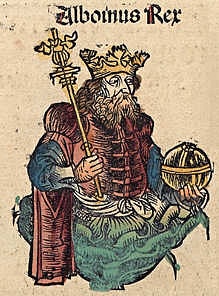
The armies met in battle some distance from Sirmium and the Gepids, under their king Cunimund, were defeated. Sources differ on what happened in the aftermath: according to some accounts, Bayan I killed Cunimund and had his skull turned into a wine cup - which he then presented to Alboin as a comrade in arms while, according others, Alboin killed Cunimund and made his skull into a cup which he then wore on his belt.
The armies marched on Sirmium but the Gepids had already called for help from the Eastern Empire, agreeing to surrender the city to them; by the time Bayan I and Alboin reached Sirmium, it was heavily defended and they were driven back. Since they had not prepared themselves for an extended siege, the armies withdrew.
Rise of the Avar Empire
Although Sirmium remained untaken, the Avars now controlled most of Pannonia and the Lombards found that the deal they had brokered earlier was an unfortunate one for them. Alboin tried to form an alliance with the Gepids against the Avars by marrying Cunimund's daughter Rosamund whom he had taken after the battle. It was now too late, though, as the Avars were simply too powerful to contest. In 568 CE, Alboin led his people out of Pannonia to Italy where, in 572 CE, he would be assassinated in a plot hatched by his wife to avenge her father.
The Avars under Bayan I then set about building their empire on the plains of Pannonia. That there seems to have been a core "Avar" ethnicity among the larger Avar confederation is seen in some of Bayan I's military decisions and decrees. The historian Denis Sinor writes:
The ethnic composition of the Avar state was not homogeneous. Bayan was followed by 10,000 Kutrighur warrior subjects already at the time of the conquest of the Gepids. In 568 he sent them to invade Dalmatia, arguing that casualties they may suffer while fighting against the Byzantines would not hurt the Avars themselves. (222)
Under Bayan I's leadership, the Avars expanded across Pannonia in every direction and, through conquest, enlarged their empire. A number of Slavic people had followed the Avars into Pannonia, and these were now subjects of Avar rule and seemed to be treated with the same lack of regard accorded the Kutrighur soldiers Sinor mentions. Bayan I oversaw the selection of the Avar base of operations in their new homeland and may have chosen it for its association with the Huns. Historian Erik Hildinger comments on this, writing:
The Avars established their headquarters near Attila's old capital of a hundred years before and fortified it. It was known as The Ring. Now well established in Pannonia, Bayan fought the Franks of Sigebert again and defeated them in 570. A dozen years later Bayan attacked Byzantine territory and seized the city of Sirmium on the Sava River. He followed this with further campaigns against the Byzantines, the Avars taking Singidunum (Belgrade) and ravaging Moesia until they were defeated near Adrianople in 587. To the Byzantines, it must have seemed like a reprise of the Hunnic aggression of the fifth century. (76)
Avar Conquest
With Sirmium now taken, and operating efficiently from The Ring, Bayan I continued his conquests. Christoph Baumer writes how Bayan I drove his armies into the Balkans and demanded tribute from the Eastern Empire for peace and then, "together with the beaten Slavs, whom they abused as a kind of 'cannon fodder', they invaded Greece in the 580's" (Volume II, 208). They operated in warfare with tactics similar to those used by the Huns a century before. Like the Huns, the Avars were expert horsemen. Baumer notes that, "The iron stirrup came to Europe only with the invading Avars in the second half of the sixth century." The stirrup "enabled riding in a squatting or almost standing position, which improved the rider's mobility, but also increased the impact of an attacking cavalry" (Volume I, 86). The stirrup greatly enhanced the already formidable Avar cavalry and made them the most feared and invincible mounted military force since the Huns. Baumer writes:
In his famous military handbook Strategikon, the Byzantine emperor Maurice (reigned 582-602) aptly described the battle style of the Avars, whom he compared to the Huns, as follows: `they prefer battles fought at long range, ambushes, encircling their adversaries, simulated retreats and sudden returns, and wedge-shaped formations...When they make their enemies take to flight, they are not content, as the Persians and the Romans, and other peoples, with pursuing them a reasonable distance and plundering their goods, but they do not let up at all until they have achieved the complete destruction of their enemies...If the battle turns out well, do not be hasty in pursuing the enemy or behave carelessly. For this nation [the steppe nomads] does not, as other do, give up the struggle when worsened in the first battle. But until their strength gives out, they try all sorts of ways to assail their enemies. (Volume I, 265-267)
Justin II had begun a war against the Sassanids in 572 CE and, with imperial forces drawn to the east, Bayan I invaded further into Byzantine territories. He demanded higher and even higher tribute and defeated the imperial armies sent against him. It was not until 592 CE, with the conclusion of the empire's war with the Sassanids, that the emperor Maurice was able to send an army of adequate force against Bayan I. The Avars were driven from the Balkans and back into Pannonia by the imperial troops under the general Priscus, almost to their capital. The Avars would most likely have been destroyed en masse were it not for the insurrection in Constantinople known as Phocas' Rebellion in 602 CE.
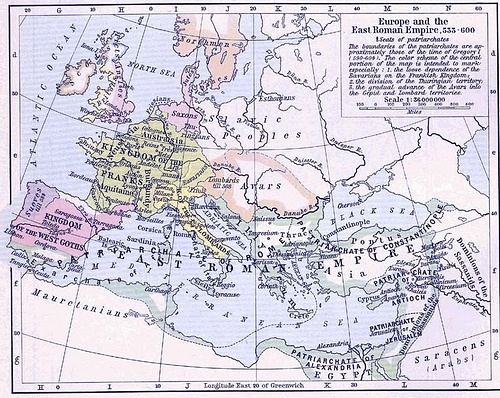
Maurice refused to allow the army to stand down and ordered them to winter in the Balkans in case the Avars should mount an unexpected attack. The soldiers rebelled and, according to the historian Theophanes (c. 760-818 CE), chose the centurion Phocas (547-610 CE) as their leader:
The soldiers put Phocas at their head, and marched on Constantinople, where he was speedily crowned, and Maurice with his five sons executed. This was on the 27th of November, 602. The usurpation of Phocas was followed by an attack on the empire, both east and west, by the Persians on the one hand and the Avars on the other. But two years later the Khagan [King of the Avars] was induced to make peace by an increased annual stipend (451).
At this same time (602 CE), a plague broke out in the Balkans and swept across the surrounding regions. It is likely that Bayan I was one of the many victims of the disease. Bayan I was succeeded by his son (whose name is not known) who attempted to carry on his father's empire. In 626 CE he led a campaign against Constantinople, allied with the Sassanid Empire, in a land and sea attack. The formidable defenses of the Theodosian Walls (built under the reign of Theodosius II, 408-450) repelled the land attack, while the Byzantine fleet defeated the naval assault, sinking many of the Avar ships. The campaign was a complete failure and the surviving Avars returned home to Pannonia.
The Decline of the Avar Empire
The emperor at this time was Heraclius (reigned 610-641 CE), who immediately stopped the payments to the Avars. Baumer notes that, "this deprived the Avar Khaganate, whose tribes and clans depended on regular distribution of goods, of their economic basis" (Volume II, 208). When Bayan's son died in 630 CE, the Bulgars of the region rose in revolt and civil war broke out between the Avars and the Bulgars. The Bulgars appealed to the Eastern Empire for assistance but they were too busy fighting off an attack by the Arabs to help, so the Bulgars pressed on by themselves. Although the Avars won this struggle, the conflict was costly and the power of the Avars declined. Baumer writes:
Archaeological research shows that Avar material culture changed after 630, for in male graves the number of weapons as burial objects declined considerably. The economy of the Avar Empire ceased to be based on wars and raids, being gradually replaced by agriculture; the former horse warriors exchanged lance and armour for the plough and now lived in houses with saddleback roofs which were dug into the ground. (Volume II, 209)
Peter Heather notes that, "just like the Huns, the Avars lacked the governmental capacity to rule their large number of subject groups directly, operating instead through a series of intermediate leaders drawn in part from those subject groups" (608). This system of government worked well as long as Bayan I ruled but, without him, led to disunity. When Charlemagne of the Franks rose to power in 768 CE, the Avars were in no position to challenge him. Charlemagne conquered the neighboring Lombards in 774 CE and then moved on the Avars but had to halt his campaign to deal with a revolt by the Saxons. Instead of taking advantage of this reprieve to strengthen their defenses and mobilize, the Avars fought among themselves and the conflict finally broke into open civil war in 794 CE in which the leaders of both factions were killed. The subordinate authority left in charge offered the remnants of the Avar Empire to Charlemagne, who accepted, but then attacked anyway in 795 CE, taking The Ring easily and carrying off the hoard of Avar treasure. The empire officially ended in 796 CE with the official surrender and, after that date, the Avars were ruled by the Franks. The Avars revolted in 799 CE but were crushed by the Franks by 802/803 CE and, afterwards, merged with other people.
Their legacy, however, was to forever change the ethnic make-up of the regions they had conquered. Peter Heather writes:
There is every reason to suppose that [the Avar Empire's system of government] had the political effect of cementing the social power of chosen subordinates, further pushing at least their Slavic subjects in the direction of political consolidation [and to] both prompt and enable a wider Slavic diaspora, as some Slavic groups moved further afield to escape the burden of Avar domination. Large-scale Slavic settlement in the former east Roman Balkans - as opposed to mere raiding - only became possible when the Avar Empire (in combination with the Persian and then Arab conquests) destroyed Constantinople's military superiority in the region. (608)
Like the Huns, to whom they are often compared, the Avars radically changed the world they inhabited. They not only displaced large numbers of people (such as the Lombards and the Slavs) but broke the political and military power of the latter half of the Roman Empire. They were among the fiercest mounted warriors in history but, as Howorth phrases it, they were also "herdsman and freebooters, and doubtless were dependent on their neighbors and slaves for their handicrafts, except perhaps that of sword-making" (810). Even their swords were linked to the Huns in that "`Hunnic swords' are referred to by the Frank chroniclers, by which perhaps Damascened blades are meant, such as those found in large numbers in a boat at Nydam in Denmark, apparently dating from this period" (Howorth, 810). The legacy of the Avars is still recognized in the present day in the populations of the lands they conquered. They are so often compared with the Huns for good reason: through their military campaigns, they significantly altered the demographics of the regions they raided, uprooting and displacing large numbers of people who then established their cultures elsewhere.
